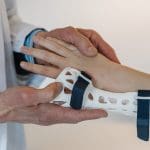
Decoding Biomechanics: The Integration of Wearable Tech in Orthopedic Rehabilitation
The intersection of biomechanics and wearable technology is revolutionizing orthopedic rehabilitation. With the ability to deliver real-time data and personalized care, wearable devices are empowering patients and enhancing outcomes for orthopedic practices. By adopting these advancements, surgeons and clinicians can push the boundaries of what’s possible in recovery and beyond.
What Is Biometrics in Wearable Technology?
Biometrics is the science of measuring and analyzing physical or biological data. When applied to wearable technology, it involves collecting information such as joint motion, muscular activity, step count, or even stress levels from devices like smart sensors or motion trackers.
For orthopedic rehabilitation, biometrics provides a window into a patient’s recovery, offering unparalleled insights into their movement patterns, progress, and overall healing process.
Wearable devices range from simple pedometers to advanced systems leveraging artificial intelligence (AI). These tools can detect subtle imbalances or inefficiencies in movement, allowing clinicians to intervene early. For example, wearable gait-analysis systems can identify atypical walking patterns post-surgery, helping physical therapists adjust recovery exercises to prevent complications.
How Wearable Tech Enables Personalized, Data-Driven Recovery
Orthopedic rehabilitation is no longer a one-size-fits-all process. Innovations in wearable tech have made it possible to craft recovery plans tailored to the precise needs of each patient. By continuously monitoring key metrics, these devices convert raw data into actionable insights that drive clinical decision-making.
Real-Time Progress Tracking
Recovering from orthopedic surgery, such as a knee replacement or rotator cuff repair, often involves weeks or months of therapy. Wearable devices facilitate continuous tracking of patients’ mobility, range of motion, and muscle engagement. Equipped with this data, clinicians can identify whether a patient is progressing as expected—or falling behind—and make interventions promptly.
For instance, a wearable sensor placed on the affected joint can monitor angles of movement during prescribed exercises. If a patient struggles to achieve optimal results, the device may send an alert to their therapist, prompting a review and adjustment of the therapy plan. Such feedback ensures patients stay on track and inspires greater compliance with their routines.
Customizing Therapy Plans
The insights gathered from wearable tech allow for highly targeted rehabilitation plans. By analyzing a patient’s biometrics, orthopedic teams can focus on specific problem areas while sparing unnecessary interventions. Devices like Electromyography (EMG) wearables, which measure muscle activity, can help therapists understand how a muscle group responds to exercises, ultimately guiding them to refine strength and agility programs.
Consider a patient recovering from Achilles tendon repair. A wearable ankle device can track the pressure exerted on the foot while walking and suggest changes to weight distribution if the data reveals potential overcompensation for the injured area. This kind of precision care encourages faster recovery with fewer setbacks.
Improving Patient Outcomes
A critical goal in orthopedic rehabilitation is reducing readmissions or complications. Wearable technology minimizes guesswork by offering precise, actionable data. Research shows that wearable-assisted physical therapy leads to enhanced outcomes and fewer long-term impairments for various orthopedic conditions. Patients gain confidence as they see measurable progress in their movement, while physicians can deliver top-tier care informed by robust data.
Take the example of shoulder replacement recovery. A wearable shoulder harness capable of monitoring range-of-motion improvements can give both patient and therapist continuous feedback. The result? Tangible progress toward recovery goals and increased satisfaction.
Pioneering the Future of Orthopedic Rehabilitation
Orthopedic practices that integrate wearable tech into their rehabilitation plans are setting new standards for postsurgical care. Staying at the forefront of these advancements positions practices as leaders in innovation, capable of achieving exceptional patient outcomes.
The future isn’t just about monitoring; it’s about building predictive models. With AI-powered wearables, practices will soon be able to forecast recovery trajectories, identifying potential risks well before symptoms surface. This proactive approach promises to elevate the quality of care while reducing costs through early intervention.
Furthermore, wearable tech complements the broader trend of telehealth. The ability to monitor patients remotely allows practices to expand their reach and serve more patients without compromising quality. A wristband that captures a range of motion and sends real-time feedback to a physical therapist, for example, demonstrates how virtual care and wearable tech seamlessly integrate, delivering convenience alongside precision.
Level Up Your Technology
Orthopedic care is evolving rapidly, and practices that adapt to technological advancements will shape the future of the field. Wearable tech isn’t just a trend; it’s a fundamental shift in how we approach rehabilitation and recovery. The integration of biometrics into everyday practice ensures better outcomes, faster recoveries, and improved patient engagement.
For orthopedic practices ready to take the next step toward innovation, consider partnering with American Orthopedic Partners (AOP). Joining this physician-led network offers invaluable support, tools, and expertise needed to drive transformational change. Together, we can deliver exceptional care while advancing the standards of orthopedic medicine.
—————————————
References:













Sorry, the comment form is closed at this time.